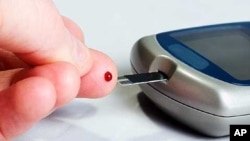Human clinical trials of an advanced artificial pancreas look promising, according to researchers, who hope the device will help insulin-dependent diabetics avoid some of the devastating complications that go along with the disease.
For years, researchers have worked to develop a computerized, artificial pancreas, one that continuously measures blood sugar levels and transmits that information electronically to an insulin pump which automatically delivers the correct dose of the hormone.
A large, landmark study by the National Institutes of Health showed that keeping blood glucose levels in a very narrow range can minimize or delay diabetic complications.
But constant blood sugar monitoring is exhausting, and even the most diligent diabetics are at risk for serious and life-threatening complications, including heart disease, blindness, kidney failure and limb amputations.
The toll diabetes takes on the body is the result of the pancreas' inability to produce insulin, the hormone that ferries glucose from food to cells. Because insulin is necessary for survival, diabetics must give themselves artificial insulin, either by injection or via an insulin pump. But it is often a guessing game: over time, too much insulin results in the dreaded complications, while too little insulin can lead to coma and death.
Henry Anhalt, director of the artificial pancreas program at Animas Corporation, which developed the Hypoglycemia-Hyperglycemia Minimizer (HHM), says the artificial pancreas requires very little input from the patient.
Currently, there are continuous glucose monitors and insulin pumps, which operate independently of each other. Consequently, Anhalt says, they require diabetics to interpret blood sugar readings from the monitor, calculate how many carbohydrates to consume, and then program how much insulin the pump should deliver.
"So let's now imagine a scenario where there is a mathematical formula that filters those glucose values through it and then makes the decisions, and commands the pump to change those insulin infusions, removing the burden from the patient to have to always be making those decisions."
Researchers tested the HHM in a group of 13 Type 1 diabetics over a 24-hour period, using a laptop to run a mathematical "filter" tailored to each patient. Anhalt says the device could eventually be operated from a smartphone, or a device integrated into the insulin pump itself.
The computer anticipated when blood sugar levels would rise above or below set limits, then increased, decreased, suspended and/or resumed the infusion of insulin accordingly.
Aaron Kowalski oversees the artificial pancreas project for the Juvenile Diabetes Research Foundation. He says the HHM worked especially well at regulating blood-sugar levels overnight, the riskiest time for diabetics since they might sleep through dangerous drops in their insulin levels or wake up feeling sick because blood glucose levels are too low.
"The artificial pancreas we believe, and the research has shown over the last few years, could significantly improve glucose control by having a computer make some of these diabetes decisions instead of the person with diabetes and, incredibly importantly, ease some of the burden," Kowalski says.
Animas Corporation unveiled its artificial pancreas system at the annual meeting of the American Diabetes Association this week.
For years, researchers have worked to develop a computerized, artificial pancreas, one that continuously measures blood sugar levels and transmits that information electronically to an insulin pump which automatically delivers the correct dose of the hormone.
A large, landmark study by the National Institutes of Health showed that keeping blood glucose levels in a very narrow range can minimize or delay diabetic complications.
But constant blood sugar monitoring is exhausting, and even the most diligent diabetics are at risk for serious and life-threatening complications, including heart disease, blindness, kidney failure and limb amputations.
The toll diabetes takes on the body is the result of the pancreas' inability to produce insulin, the hormone that ferries glucose from food to cells. Because insulin is necessary for survival, diabetics must give themselves artificial insulin, either by injection or via an insulin pump. But it is often a guessing game: over time, too much insulin results in the dreaded complications, while too little insulin can lead to coma and death.
Henry Anhalt, director of the artificial pancreas program at Animas Corporation, which developed the Hypoglycemia-Hyperglycemia Minimizer (HHM), says the artificial pancreas requires very little input from the patient.
Currently, there are continuous glucose monitors and insulin pumps, which operate independently of each other. Consequently, Anhalt says, they require diabetics to interpret blood sugar readings from the monitor, calculate how many carbohydrates to consume, and then program how much insulin the pump should deliver.
"So let's now imagine a scenario where there is a mathematical formula that filters those glucose values through it and then makes the decisions, and commands the pump to change those insulin infusions, removing the burden from the patient to have to always be making those decisions."
Researchers tested the HHM in a group of 13 Type 1 diabetics over a 24-hour period, using a laptop to run a mathematical "filter" tailored to each patient. Anhalt says the device could eventually be operated from a smartphone, or a device integrated into the insulin pump itself.
The computer anticipated when blood sugar levels would rise above or below set limits, then increased, decreased, suspended and/or resumed the infusion of insulin accordingly.
Aaron Kowalski oversees the artificial pancreas project for the Juvenile Diabetes Research Foundation. He says the HHM worked especially well at regulating blood-sugar levels overnight, the riskiest time for diabetics since they might sleep through dangerous drops in their insulin levels or wake up feeling sick because blood glucose levels are too low.
"The artificial pancreas we believe, and the research has shown over the last few years, could significantly improve glucose control by having a computer make some of these diabetes decisions instead of the person with diabetes and, incredibly importantly, ease some of the burden," Kowalski says.
Animas Corporation unveiled its artificial pancreas system at the annual meeting of the American Diabetes Association this week.










